Bitcoin
The tariff war fallout: Is crypto to the rescue?
Published
6 days agoon
By
admin
Disclosure: The views and opinions expressed here belong solely to the author and do not represent the views and opinions of crypto.news’ editorial.
The Trump administration introduced new tariffs and expanded existing ones, which resulted in increasing trade tensions among major partners like China, the European Union, and Mexico. Global financial markets are significantly impacted by these actions, which causes increased economic uncertainty and volatility. These tariffs are aimed at a range of products, from aluminium and steel to cars and various electronic components. Unsurprisingly, some countries have responded with counter-tariffs on US exports, which could potentially trigger a big trade war.
This back-and-forth has resulted in increased trade barriers, which are slowing down economic growth—a trend that’s evident in recent macroeconomic indicators, including the Conference Board consumer sentiment index. Consequently, forecasts for US GDP growth have been adjusted downward due to the impact of these tariffs. The automotive sector, which relies heavily on imported parts, is also feeling the pinch, with Ford Motor Co. recently announcing a significant cut in expected dividends.
How trade barriers are turning Bitcoin into a global safe haven
Donald Trump’s recent actions prove that his attitude towards his tariffs is very consistent and goal-oriented, which has sparked a ‘contrarian’ positive outlook for cyclically resistant investment assets, where Bitcoin (BTC) occupies a special position. With rising tariffs and inflation worries, more people are turning to alternative, discorrelated assets, which are broadly viewed as a safeguard against both inflation and impending economic instability in general.
Historically, Bitcoin has proven to be quite resilient during tough economic times. For instance, during market upheavals—like the banking sector turmoil we saw in 2023 following the collapse of Silicon Valley Bank—Bitcoin evidently experienced price surges, hinting at a “flight to safety” trend being formed robustly and meaningfully. However, to date, such trends remain mostly perceptional and, therefore, unfortunately, hard to quantify and algorithmize.
Having said that, the fact that the US is still at the forefront of various innovative efforts in cryptocurrency and AI somewhat mitigates the broader implications of the tariff situation. Recently, Senator Cynthia Lummis (R-WY) put forth a legislative proposal suggesting that the US should acquire one million BTC, representing about 5% of the total fixed supply. This initiative is expected to spark a new wave of significant activity in the crypto market.
The combination of supportive government policies for crypto and the expectation of more tariff actions will likely create a complex but potentially very favorable market sentiment for Bitcoin. Once again, investors, swayed by these developments, are starting to see Bitcoin as a safe haven with the potential for sustained growth in a post-tariff landscape. The current market vibe, shaped by Trump’s tariff strategies and the prospect of long-term shifts, makes Bitcoin look like a low-downside-high-reward investment opportunity.
AI and robotics: Winners in the tariff war
Meanwhile, AI-aided automation and robotics are on the rise as increasing import costs from China push American manufacturers to cut labor costs. Similarly, countries like Vietnam and India are reaping the benefits as global companies relocate their manufacturing operations from China to avoid tariff-related expenses. Additionally, I see a lot of promise in sectors like AI, nuclear energy, and other manufacturing industries, which have the chance to set up operations in the United States.
Integrating AI and automation within manufacturing industries can drive greater adoption of Bitcoin as a secure and efficient method of financial transactions, incorporated into metaverse and web3 ecosystems. Furthermore, the demand for AI technologies to support automated processes will likely surge, presenting new investment opportunities in the AI sector. Most importantly, the synergy between AI-aided automation, robotics, Bitcoin, and AI investments has the potential to reshape the future of the manufacturing and technology industries, which will drive even more attention to Bitcoin.
Tariffs, trade wars, and rising risks: What investors should watch out for
Trade barriers may—at least initially—disrupt certain supply chains, increase business costs, and reduce export demand due to retaliatory tariffs. Instability in one major market or economy due to trade tensions can spill over to other countries and regions, creating a global ripple effect. This can lead to lower investment, reduced hiring, and overall slower economic expansion, potentially even triggering a recession where gold and alternative assets like Bitcoin would definitely play special risk aversion roles, making their increasingly anti-correlative Betas more and more attractive for ordinary investors to “join the club.”
It is important to keep the focus on the long term and invest in industries with high potential, such as AI, nuclear energy, healthcare, and rare earth metals. There may be some transitory, recoverable meltdown because the market is overvalued due to years of way-too-buoyant liquidity and overrated optimism. Still, if companies decide to quickly move to make production in the US and replace costly outsourcing, they have a great future due to the huge domestic market in this world’s largest economy.
To navigate the challenges of this shaky market, both private investors and institutions can use a variety of diversification strategies. One effective approach is asset class diversification, which involves spreading investments across different types of assets like stocks, bonds, real estate, commodities, and certainly alternative options like Bitcoin and other cryptocurrencies. Additionally, it’s important to consider both developed and emerging markets while using various investment strategies—like value investing, growth investing, or dividend investing—which normally yield different results in different market conditions.
Final words
Currently, the market’s reaction to Trump’s tariffs suggests that Bitcoin is becoming more discorrelated to broader macroeconomic and geopolitical factors and, hence, more appealing regarding both asset-protection and investment portfolio hedging purposes. Historically, Bitcoin demonstrated notable resistance to economic cycles and episodes of banking system instability. Now, it offers a legitimate test of its suitability as a risk aversion tool for real-world economic troubles. Its inclusion in the U.S. strategic reserve further underpins this thesis.

John Murillo
John Murillo is the chief dealing officer of B2BROKER, a global fintech solutions provider for financial institutions. John is a seasoned trading professional with more than 20 years of experience in capital markets. Throughout his professional life, John has managed broker-dealer business, performed risk management for trading desks with high volumes, and worked with institutional clients worldwide to deliver tailored liquidity solutions. He has been part of B2BROKER since its early days, ensuring the company grows and functions effectively. At B2BROKER, he is responsible for all the facets of liquidity, ensuring client setups are seamless before going live and enhancing internal risk management procedures. Treasury operations, creating strategic services, and expanding international market presence are also among his duties.
Source link
You may like


Crypto Trader Says Solana Competitor Starting To Show Bullish Momentum, Updates Outlook on Bitcoin and Ethereum


weakness signals move toward lower support


Now On Sale For $70,000: The World’s First Factory Ready Open-Source Humanoid Robot


What Next for ETH as Traders Swap $86M into Solana DeFi protocols ?


Why Did Bitcoin Price (BTC) Fall on Wednesday Afternoon


Solana price is up 36% from its crypto market crash lows — Is $180 SOL the next stop?
Altcoins
Crypto Trader Says Solana Competitor Starting To Show Bullish Momentum, Updates Outlook on Bitcoin and Ethereum
Published
18 minutes agoon
April 17, 2025By
admin
A widely followed crypto analyst says one Solana (SOL) competitor may be gearing up for a breakout.
In a new thread, crypto trader Michaël van de Poppe tells his 783,000 followers on the social media platform X that Sei (SEI) may increase more than 100% its current value if it breaks through a key resistance level.
“SEI starts to show momentum. The Bitcoin pair has a strong bullish divergence on the higher timeframes and the USD pair faces a crucial resistance. Breaking through $0.20 opens up a continuation towards $0.30-$0.35.”

SEI is trading for $0.17 at time of writing, down 2.4% in the last 24 hours.
Next up, the analyst says that Bitcoin (BTC) is in a consolidation phase that may lead to an explosive move to the upside.
“Bitcoin is stuck in the final range. Another test of $87,000 and we’ll likely break upwards to the rally of a new all-time high.”
Bitcoin is trading for $83,800 at time of writing, flat on the day.
Lastly, the analyst says that Ethereum (ETH) may be kicking off an uptrend if the price of gold peaks, based on ETH’s historic inverse correlation with the precious metal.
“A good start of the week, as ETH is +4% against Bitcoin. The ultimate question whether it will sustain or not, last months it has been giving back the returns in the days after. What to monitor? Gold peaking or not. If that’s the case, then we’ll see more strength on ETH.”
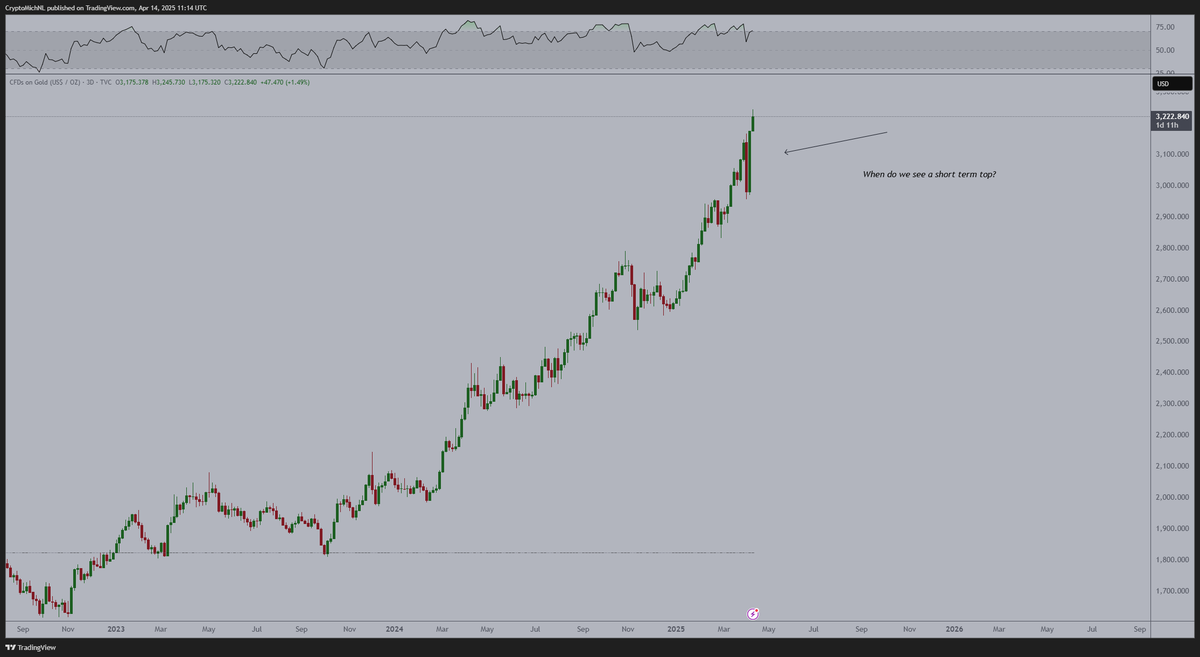
The analyst also says that ETH’s Relative Strength Index (RSI) indicator is flashing bullish, having entered oversold territory.
The RSI is a momentum oscillator used to determine whether an asset is oversold or overbought. The RSI’s values range from zero to 100. A level between 70 and 100 indicates that an asset is overbought. The 0 to 30 level range indicates that an asset is oversold.
“It’s been a bear market for 1,225 days for ETH, as, in this period, gold did a 2x. The lowest RSI on the weekly candle for ETH as well.”
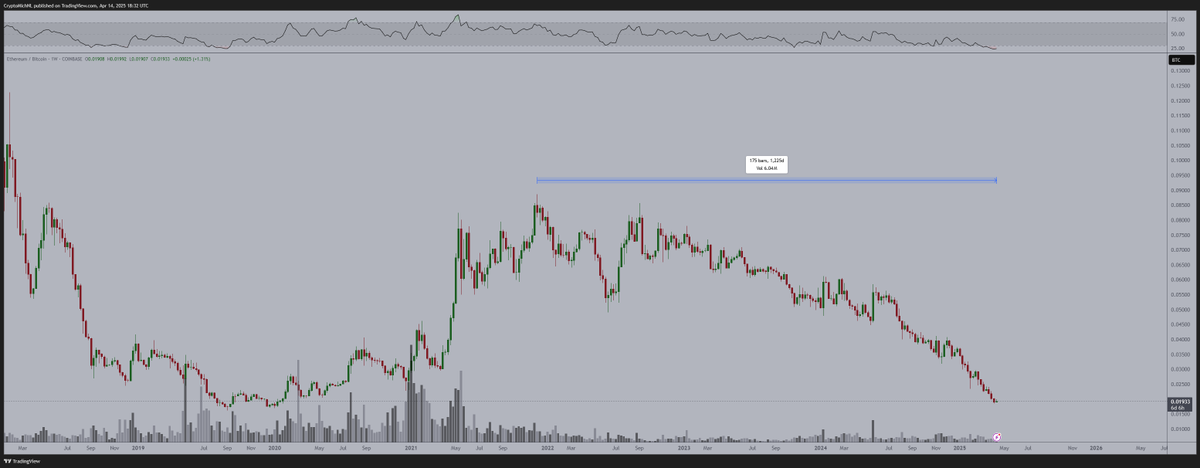
ETH is trading for $1,589 at time of writing, down 2% in the last 24 hours.
Follow us on X, Facebook and Telegram
Don’t Miss a Beat – Subscribe to get email alerts delivered directly to your inbox
Check Price Action
Surf The Daily Hodl Mix
 

Disclaimer: Opinions expressed at The Daily Hodl are not investment advice. Investors should do their due diligence before making any high-risk investments in Bitcoin, cryptocurrency or digital assets. Please be advised that your transfers and trades are at your own risk, and any losses you may incur are your responsibility. The Daily Hodl does not recommend the buying or selling of any cryptocurrencies or digital assets, nor is The Daily Hodl an investment advisor. Please note that The Daily Hodl participates in affiliate marketing.
Generated Image: Midjourney
Source link
Bitcoin
Why Did Bitcoin Price (BTC) Fall on Wednesday Afternoon
Published
4 hours agoon
April 16, 2025By
admin
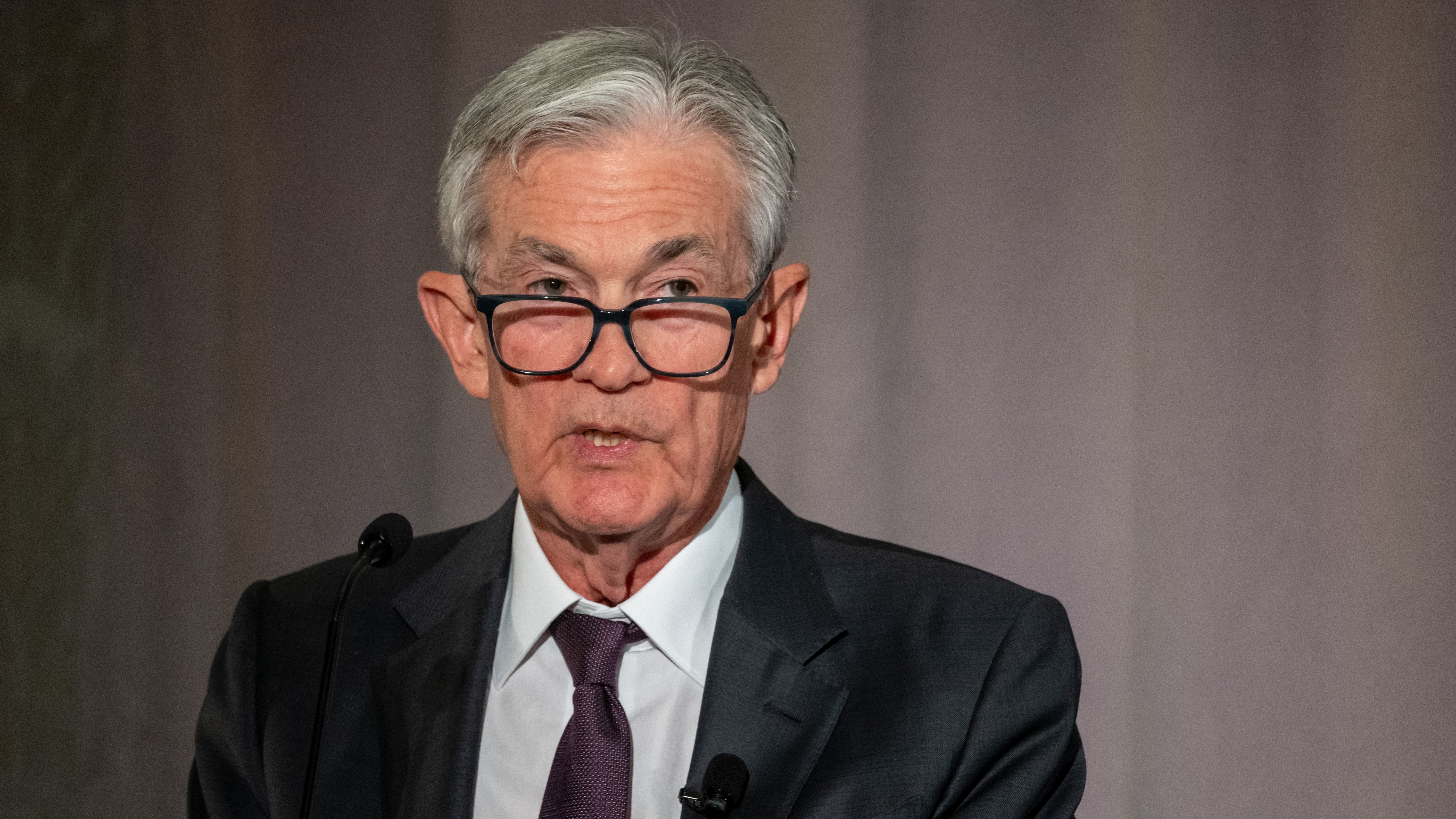
A modest bitcoin rally to a possible challenge of the $86,000 level quickly reversed during U.S. afternoon trading hours on Wednesday as Federal Reserve Chairman Jerome Powell warned on the effects of President Trump’s tariff regime.
“The level of the tariff increases announced so far is significantly larger than anticipated,” said Powell in a speech. “The same is likely to be true of the economic effects, which will include higher inflation and slower growth.”
In other words, stagflation — a throwback to a sizable portion of the 1970s when the U.S. experienced weak economic activity alongside double-digit inflation.
“We may find ourselves in the challenging scenario in which our dual-mandate goals are in tension,” continued Powell.
The price of bitcoin (BTC) fell about 2.5% in the minutes following the Powell remarks, now trading at $83,700, down 1.5% over the past 24 hours.
U.S. stocks, which had been trying to mount a comeback from opening declines, also were hit, the Nasdaq slumping 3.4% to a session low.
Powell also mentioned that as crypto is becoming more mainstream, there’s a need for a legal framework for stablecoins. He said that banking regulation around crypto will likely be “partially relaxed.”
The U.S. Senate Banking Committee cleared a bill to regulate stablecoin issuers in March, marking the first committee approval and a significant step closer to law in the U.S.
Hawkish Fed weighs on crypto and BTC
“Powell came out extremely hawkish,” Quinn Thompson, chief investment officer of hedge fund Lekker Capital, said in a Telegram message. It’s notable that Powell downplayed last week’s market turmoil characterizing it as “orderly market functioning,” he added.
“I would have at least expected him to give a nod to the elevated volatility and ruptures forming in the treasury market but he did not do that,” Thompson said.
Powell’s tone suggests that investors should temper their expectations for rate cuts in the upcoming meetings, said Thompson, which could weigh on risk assets including crypto.
“It appears a May cut is firmly off the table barring Fed intervention for bad reasons and I wouldn’t say June is a lock either,” concluded Thompson. “The bull case for crypto and bitcoin specifically is liquidity and policymaker intervention. Both of those seemed very far off based, so it’s difficult for me to paint a constructive picture in the immediate term.”
UPDATE (April 16, 18:40 UTC): Adds additional comments made by Chair Powell about stablecoins. Adds analyst comment.
Source link
Bitcoin
How Expanding Global Liquidity Could Drive Bitcoin Price To New All-Time Highs
Published
6 hours agoon
April 16, 2025By
admin
Bitcoin’s price trajectory is once again capturing headlines, and this time the catalyst appears to be global liquidity trends reshaping investor sentiment. In a recent comprehensive breakdown, Matt Crosby, Lead Analyst at Bitcoin Magazine Pro, presents compelling evidence tying the digital asset’s renewed bullish momentum to the expanding global M2 money supply. His insights not only illuminate the future of Bitcoin price but also anchor its macroeconomic relevance in a broader financial context.
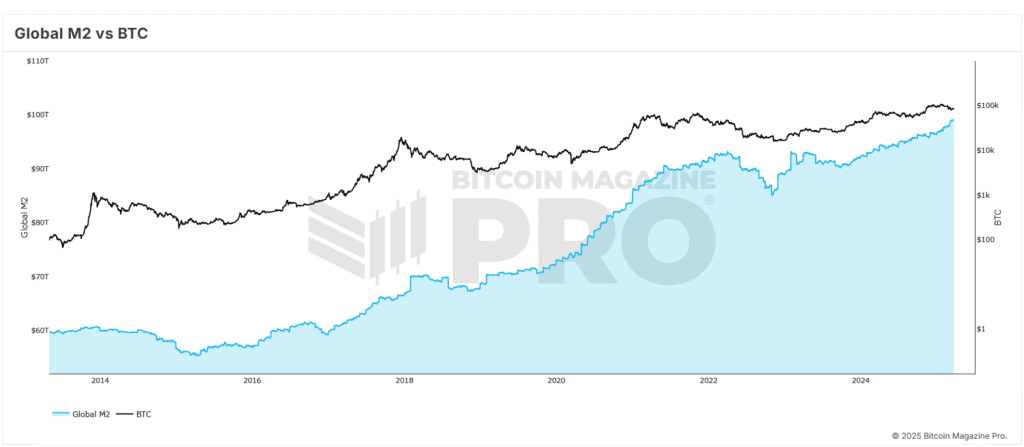
Bitcoin Price and Global Liquidity: A High-Impact Correlation
Crosby highlights a remarkable and consistent correlation—often exceeding 84%—between Bitcoin price and global M2 liquidity levels. As liquidity increases across the global economy, Bitcoin price typically responds with upward movement, although with a noticeable delay. Historical data supports the observation of a 56–60 day lag between monetary expansion and Bitcoin price increases.
This insight has recently proven accurate, as Bitcoin price rebounded from lows of $75,000 to above $85,000. This trend closely aligns with the forecasted recovery that Crosby and his team had outlined based on macro indicators, validating the strength and reliability of the correlation driving Bitcoin price upward.
Why the 2-Month Delay Impacts Bitcoin Price
The two-month delay in market response is a critical observation for understanding Bitcoin price movements. Crosby emphasizes that monetary policy and liquidity injections do not immediately affect speculative assets like BTC. Instead, there is an incubation period, typically around two months, during which liquidity filters through financial systems and begins to influence Bitcoin price.
Crosby has optimized this correlation through various backtests, adjusting timeframes and offsets. Their findings indicate that a 60-day delay yields the most predictive accuracy across both short-term (1-year) and extended (4-year) historical Bitcoin price action. This lag provides a strategic advantage to investors who monitor macro trends to anticipate Bitcoin price surges.
S&P 500 and Its Influence on Bitcoin Price Trends
Adding further credibility to the thesis, Crosby extends his analysis to traditional equity markets. The S&P 500 exhibits an even stronger all-time correlation of approximately 92% with global liquidity. This correlation strengthens the argument that monetary expansion is a significant driver not just for Bitcoin price, but also for broader risk-on asset classes.
By comparing liquidity trends with multiple indices, Crosby demonstrates that Bitcoin price is not an anomaly but part of a broader systemic pattern. When liquidity rises, equities and digital assets alike tend to benefit, making M2 supply an essential indicator for timing Bitcoin price movements.
Forecasting Bitcoin Price to $108,000 by June 2025
To build a forward-looking perspective, Crosby employs historical fractals from previous bull markets to project future Bitcoin price movements. When these patterns are overlaid with current macro data, the model points to a scenario where Bitcoin price could retest and potentially surpass its all-time highs, targeting $108,000 by June 2025.
This optimistic projection for Bitcoin price hinges on the assumption that global liquidity continues its upward trajectory. The Federal Reserve’s recent statements suggest that further monetary stimulus could be deployed if market stability falters—another tailwind for Bitcoin price growth.
The Rate of Expansion Affects Bitcoin Price
While rising liquidity levels are significant, Crosby stresses the importance of monitoring the rate of liquidity expansion to predict Bitcoin price trends. The year-on-year M2 growth rate offers a more nuanced view of macroeconomic momentum. Although liquidity has generally increased, the pace of expansion had slowed temporarily before resuming an upward trend in recent months.

This trend is strikingly similar to conditions observed in early 2017, just before Bitcoin price entered an exponential growth phase. The parallels reinforce Crosby’s bullish outlook on Bitcoin price and emphasize the importance of dynamic, rather than static, macro analysis.
Final Thoughts: Preparing for the Next Bitcoin Price Phase
While potential risks such as a global recession or a significant equity market correction persist, current macro indicators point toward a favorable environment for Bitcoin price. Crosby’s data-driven approach offers investors a strategic lens to interpret and navigate the market.
For those looking to make informed decisions in a volatile environment, these insights provide actionable intelligence grounded in economic fundamentals to capitalize on Bitcoin price opportunities.
For more deep-dive research, technical indicators, real-time market alerts, and access to a growing community of analysts, visit BitcoinMagazinePro.com.

Disclaimer: This article is for informational purposes only and should not be considered financial advice. Always do your own research before making any investment decisions.
Source link

Crypto Trader Says Solana Competitor Starting To Show Bullish Momentum, Updates Outlook on Bitcoin and Ethereum

weakness signals move toward lower support

Now On Sale For $70,000: The World’s First Factory Ready Open-Source Humanoid Robot

What Next for ETH as Traders Swap $86M into Solana DeFi protocols ?

Why Did Bitcoin Price (BTC) Fall on Wednesday Afternoon

Solana price is up 36% from its crypto market crash lows — Is $180 SOL the next stop?

Solana Retests Bearish Breakout Zone – $65 Target Still In Play?

How Expanding Global Liquidity Could Drive Bitcoin Price To New All-Time Highs

Apple Delists 14 Crypto Apps in South Korea Including KuCoin and MEXC Exchanges Amid Regulatory Crackdown

Athens Exchange Group eyes first onchain order book via Sui

Futureverse Acquires Candy Digital, Taps DC Comics and Netflix IP to Boost Metaverse Strategy
Court Grants Ripple And SEC’s Joint Motion To Suspend Appeal

AVAX Falls 2.1% as Nearly All Assets Trade Lower

What is a VTuber, and how do you become one in 2025?

Top Expert’s Update Sets $10 Target

Arthur Hayes, Murad’s Prediction For Meme Coins, AI & DeFi Coins For 2025

Expert Sees Bitcoin Dipping To $50K While Bullish Signs Persist

Aptos Leverages Chainlink To Enhance Scalability and Data Access

Bitcoin Could Rally to $80,000 on the Eve of US Elections

Crypto’s Big Trump Gamble Is Risky

Institutional Investors Go All In on Crypto as 57% Plan to Boost Allocations as Bull Run Heats Up, Sygnum Survey Reveals

Sonic Now ‘Golden Standard’ of Layer-2s After Scaling Transactions to 16,000+ per Second, Says Andre Cronje

3 Voting Polls Show Why Ripple’s XRP Price Could Hit $10 Soon

Ripple-SEC Case Ends, But These 3 Rivals Could Jump 500x

Has The Bitcoin Price Already Peaked?

The Future of Bitcoin: Scaling, Institutional Adoption, and Strategic Reserves with Rich Rines

A16z-backed Espresso announces mainnet launch of core product

Xmas Altcoin Rally Insights by BNM Agent I

Blockchain groups challenge new broker reporting rule

I’m Grateful for Trump’s Embrace of Bitcoin
Trending

 24/7 Cryptocurrency News5 months ago
24/7 Cryptocurrency News5 months agoArthur Hayes, Murad’s Prediction For Meme Coins, AI & DeFi Coins For 2025

 Bitcoin3 months ago
Bitcoin3 months agoExpert Sees Bitcoin Dipping To $50K While Bullish Signs Persist

 24/7 Cryptocurrency News3 months ago
24/7 Cryptocurrency News3 months agoAptos Leverages Chainlink To Enhance Scalability and Data Access

 Bitcoin5 months ago
Bitcoin5 months agoBitcoin Could Rally to $80,000 on the Eve of US Elections

 Opinion5 months ago
Opinion5 months agoCrypto’s Big Trump Gamble Is Risky

 Bitcoin5 months ago
Bitcoin5 months agoInstitutional Investors Go All In on Crypto as 57% Plan to Boost Allocations as Bull Run Heats Up, Sygnum Survey Reveals

 Altcoins3 months ago
Altcoins3 months agoSonic Now ‘Golden Standard’ of Layer-2s After Scaling Transactions to 16,000+ per Second, Says Andre Cronje
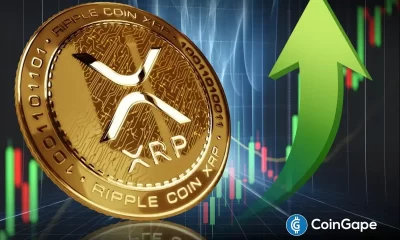
 Ripple Price4 weeks ago
Ripple Price4 weeks ago3 Voting Polls Show Why Ripple’s XRP Price Could Hit $10 Soon


